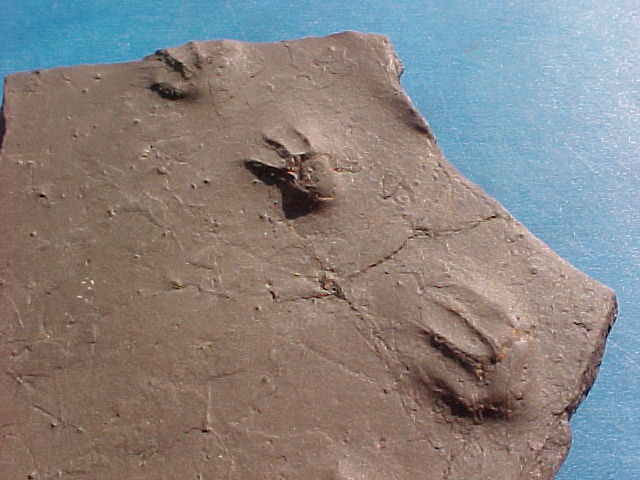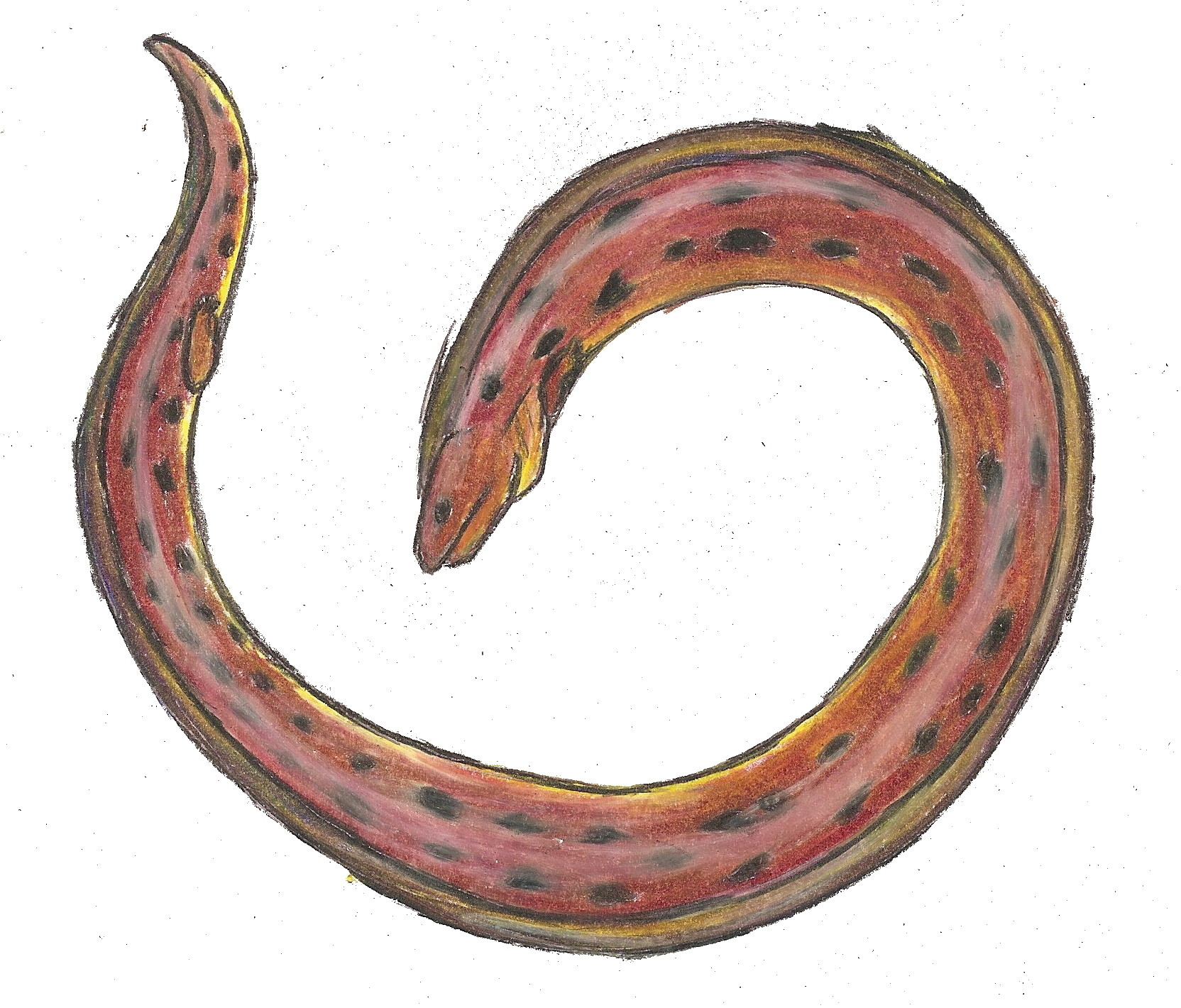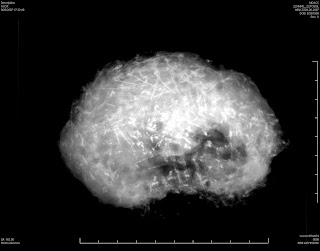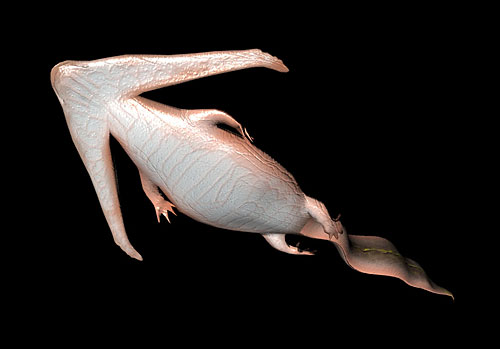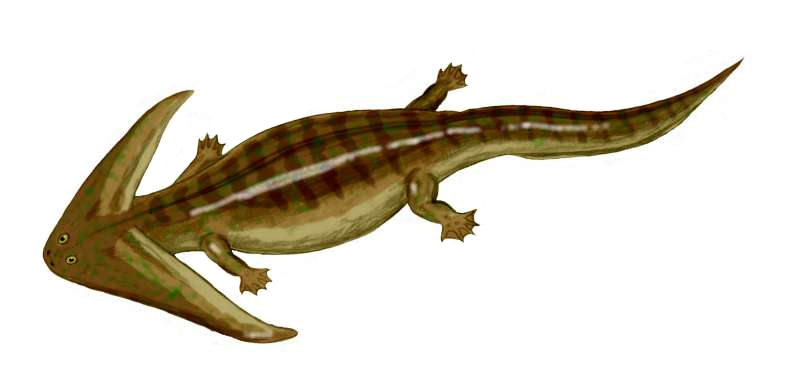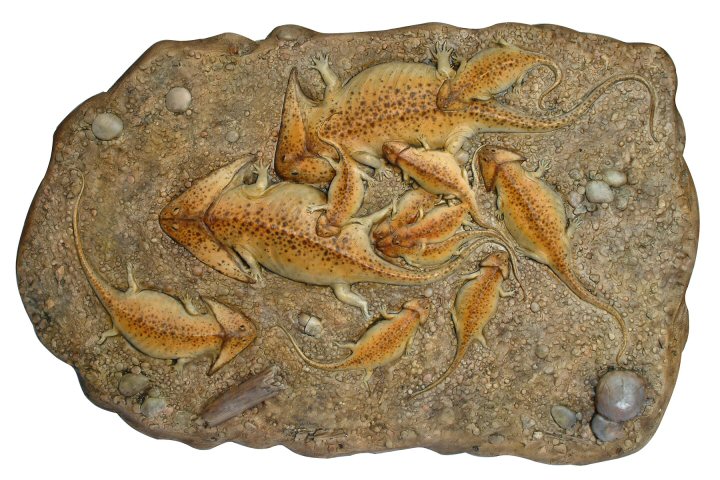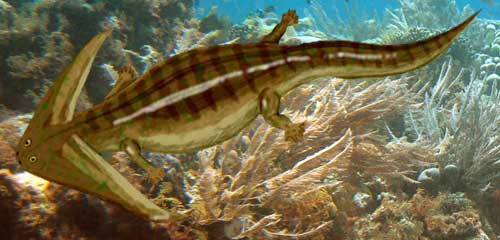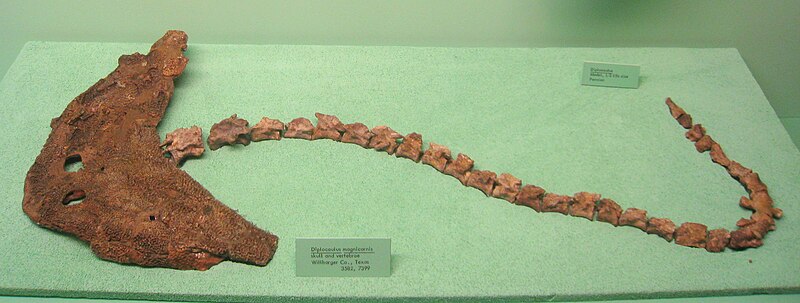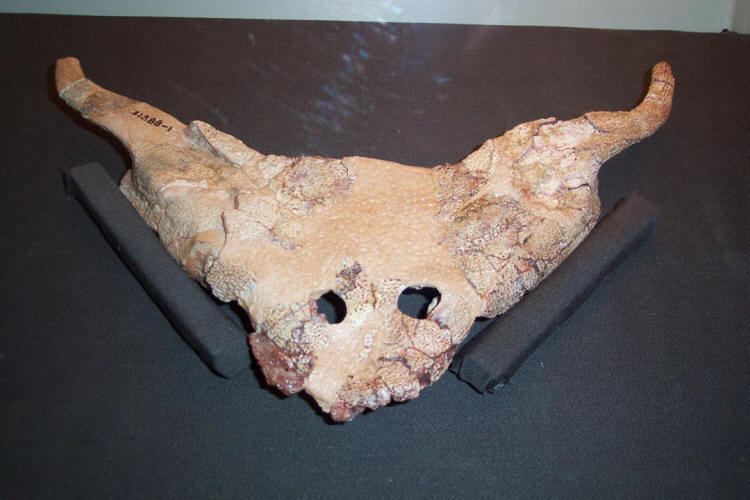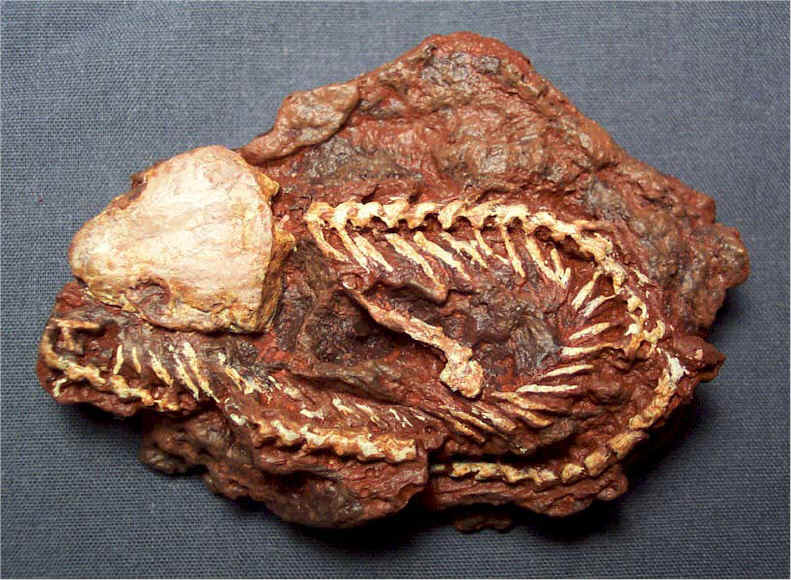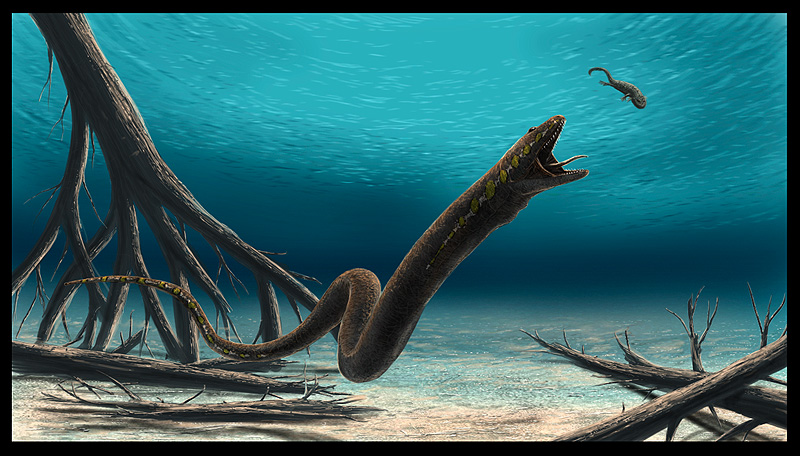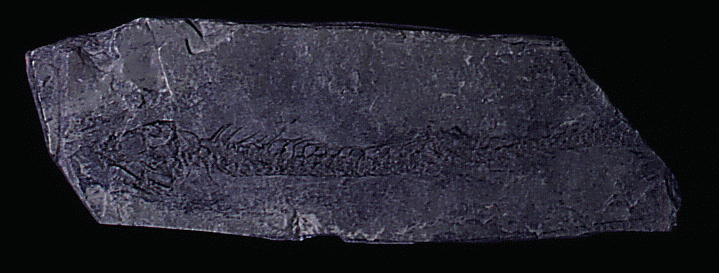[Recent Entries][Archive][Friends][User Info]
Below are the 18 most recent journal entries recorded in the "Сообщество, посвящённое ра" journal:| October 27th, 2011 | |
|---|---|
| 08:08 pm [industrialterro] [Link] |
Rhynchonkos Rhynchonkos — вымерший род микрозавров. Единственный род семейства Goniorhynchidae. Ранее известный как Goniorhynchus получил современное название в 1981 году. Единственный вид — R. stovalli. Обнаружен в формации Хеннеси (округ Кливленд, Оклахома) раннего пермского периода. Rhynchonkos обладает существенным сходством с ранними безногими земноводными раннего юрского периода Eocaecilia, найденными в Аризоне. Считалось, что безногие земноводные произошли от микрозавров, что сейчас оспаривается. Rhynchonkos has an elongated body with at least 37 presacral vertebrae. Most vertebrae have ribs. Unlike other microsaurs, the atlas of Rhynchonkos lacks ribs. Both Rhynchonkos and Euryodus have atlases that bear a strong resemblance to those of nectrideans. Like nectrideans, the arch of the atlas is attached to the centrum, although this is likely the result of convergence. The skull is triangular in dorsal view. The limbs are very small. It has a pointed, overhanging snout that extends beyond the tooth row. There are five or six premaxillary teeth and sixteen maxillary teeth, all of which are narrow and peg-shaped. The palate also has teeth, with rows on the ectopterygoid, palatine, and vomer. The bones of the skull roof are similar to those of gymnarthrids. There are two rows of teeth adjacent to one another in the lower jaw, with a marginal row on the dentary and an inner row on the coronoid. Rhynchonkos shares many features with the early caecilian Eocaecilia, including an elongated trunk, small limbs, and a similar skull. Based on these features, caecilians seemed to have originated from Rhynchonkos or another closely related microsaur. Carroll and Currie (1975), the first to suggest this possible relationship, noted similarities in temporal fenestration, palatal structure, braincase composition, and mandibular dentition. In the temporal region of the skulls of Rhynchonkos and caecilians, the number of bones are reduced. Both Rhynchonkos and caecilians possess a primitive combination of palatal bones, including the ectopterygoid. The two taxa also have rows of teeth on the palate in addition to the marginal rows on the maxilla and premaxilla. Carrol and Currie also mentioned that Rhynchonkos and caecilians have a pleurosphenoid that joins the otic-occipital portion of the braincase with the sphenethmoid, a characteristic which they considered unique among amphibians. The adjacent tooth rows on the coronoid and the dentary of Rhynchonkos were also considered a characteristic that linked it with caecilians. Despite these similarities, many of the characteristics that suggested a close relationship between Rhynchonkos and caecilians have since been considered primitive, convergent, or indeterminate. For example, tooth rows on the palate have evolved multiple times independently in early amphibians. The general appearance of Rhynchonkos is similar to that of caecilians, but is also similar to other amphibians that have independently developed elongated bodies. Adelospondyls, lysorophians, aïstopods, and some salamanders all have an increased number of vertebrae that lengthen the body. Reduced limbs are seen in many aquatic or burrowing amphibians, and are not unique to microsaurs and caecilians.
Tags: Вымершие амфибии, Лабиринтодонты, Лепоспондилы, Пермь |
| October 26th, 2011 | |
| 07:57 pm [industrialterro] [Link] |
Pantylus Pantylus is an extinct lepospondyl amphibian from the Permian period of North America. Pantylus was probably a largely terrestrial animal, judging from its well-built legs. It was about 25 centimetres (10 in) long, and resembled a lizard with a large skull and short limbs. It had numerous blunt teeth, and probably chased after invertebrate prey.
Tags: Вымершие амфибии, Лабиринтодонты, Лепоспондилы, Пермь |
| 07:34 pm [industrialterro] [Link] |
Micraroter Micraroter is an extinct genus of microsaur within the family Ostodolepidae. Ostodolepidae is an extinct family of tuditanomorph microsaurs. They are unique among microsaurs in that they were large, reaching lengths of up to 2 feet (61 cm), terrestrial, and presumably fossorial. Ostodolepid remains have been found from Early Permian beds in Texas and Oklahoma. Ostodolepids have elongated trunks, with small, robust limbs and shortened tails. The occiput is high, but the skull narrows toward the snout. The snout is pointed and projects past the jaw. In dorsal view, the skull is roughly triangular. The ventral temporal margin is emarginated. At the back of the skull, there is a large cavity between the supraoccipital and the skull roof. The skull is well ossified, with tight sutures between bones. The skull roof is relatively smooth, although scattered pits and grooves are usually present. There are 32 to 45 presacral vertebrae, and three sacral vertebrae
Tags: Вымершие амфибии, Лабиринтодонты, Лепоспондилы, Пермь |
| October 25th, 2011 | |
| 08:59 pm [industrialterro] [Link] |
Lysorophus Lysorophus is a genus of Lysorophia, extinct Permian Lepospondyl tetrapods. Most of the specimens are found from North America and attributed to the first formally described species Lysorophus tricarinatus due to the lack of diagnostic characters, but several other species have been described. Lysorophus were small salamander-like amphibians. They lived in fresh water, aestivating in burrows during dry periods. Lysorophia is an order of aquatic Carboniferous and Permian amphibians within the extinct subclass Lepospondyli. Lysorophians resembled small snakes, as their bodies are extremely elongate. There is a single family, the Lysorophidae. Currently there are around five genera included within Lysorophia. The skull is lightly built and open, with large orbits and fenestrae. The intertemporal, supratemporal, postfrontal, and jugal bones of the skull have disappeared. The mandibles are short, and the maxilla and premaxilla freely movable. The torso is very elongate, the limbs diminutive or absent, and the tail short. There are up to 99 pre-sacral (i.e. not including the hips and tail) vertebrae. Based on morphology of the cranio-vertebral articulation, Lysorophids are usually considered to be related to the Microsauria, although the pattern of bones of the skull is very different. Lysorophians are known mainly from the Late Pennsylvanian and Early Permian of North America. In North America, fossils of lysorophians have been found from places such as the Chinle Formation in San Juan County, Utah and the Mazon Creek fossil beds in Grundy County, Illinois. Carboniferous lysorophians are also known from Europe, having been found from England and Ireland. Possible remains of a lysorophian have also been found from La Machine, France, although they may belong to an aïstopod.
Tags: Вымершие амфибии, Лабиринтодонты, Лепоспондилы, Пермь |
| 08:50 pm [industrialterro] [Link] |
Konzhukovia Konzhukovia is an extinct genus of stereospondylomorph temnospondyl amphibian in the family Archegosauridae. The type species is Konzhukovia vetusta. Мелозавры (Melosauridae) – семейство темноспондилов пермской эпохи. Относятся к надсемейству архегозавроидов, родичи архегозавров и платиопозавров. Отличаются относительно короткой широкой мордой. Череп высокий в задней части, морда относительно плоская. Глазницы направлены вверх. Ноздри крупные. Череп с хорошо выраженным скуловым изгибом и пережимом позади ноздрей. Передние небные ямы парные, с отвесными передними и боковыми стенками. Альвеола последнего зуба предчелюстной кости значительно меньше двух предыдущих альвеол. В парахоанальном зубном ряду сошника до шести зубов. Многочисленные шагреневые зубы на сошниках. Затылочный мыщелок парный. Ушные вырезки крупные. Название («черные ящеры») происходит от цвета породы, вмещавшей первые находки. Второе подсемейство – трифозухины (Tryphosuchinae). Их отличает нерасширенный передний конец черепа; расположение заднего края хоаны позади уровня переднего края межптеригоидного окна; загнутый вверх передний конец нижней челюсти с Г-образным изгибом (в плане) симфизной части; узкая зубная кость позади симфиза без горизонтальной пластины; меньшая массивность околосуставного блока нижней челюсти; очень крупные по отношению к передним зубам нижней челюсти симфизные клыки; более мелкая скульптура ячеистого и радиально-ячеистого типа на угловой кости. Наиболее известен род конжуковия (Konzhukovia). Описан Е.Д. Конжуковой как Melosaurus vetustus в 1955 году. Новое название рода введено Ю.М. Губиным в 1991 году. Череп типовой особи длиной 28 см, шириной 16 см, высотой 6 см – это старый экземпляр. Мощные небные «клыки» в передней части черепа, морда низкая, сам череп высокий. Тазовые кости сходны с тазом эриопса. Возможно, это указывает на полуназемный образ жизни.
Tags: Вымершие амфибии, Лабиринтодонты, Лепоспондилы, Пермь |
| 07:51 pm [industrialterro] [Link] |
Diploceraspis Diploceraspis was a lepospondyl amphibian. It lived in Ohio during the Permian period. It closely resembles Diplocaulus, and is a relative. It generally sports the same features as Diplocaulus.
Tags: Вымершие амфибии, Лабиринтодонты, Лепоспондилы, Пермь |
| October 24th, 2011 | |
| 10:03 pm [industrialterro] [Link] |
Diplocaulus Диплокаулус (Diplocaulus) — вымершее примитивное четвероногое («земноводное») из группы лепоспондилов. Принадлежит к отряду нектридий (Nectridea). Входит в семейство Diplocaulidae (Keraterpetontidae). Наиболее заметный признак — расширенная в виде бумеранга голова. Выросты образованы таблитчатыми и чешуйчатыми костями. Череп очень плоский. Рот маленький, нижняя челюсть не связана с боковыми выростами. Кости неба прирастают к мозговой коробке, развиты ямы между крыловидными костями. Тело плоское, расширенное (почти листовидной формы). Конечности короткие. Хвост описывают как короткий, но на изображениях полного скелета изображают длинным, почти бичевидным. У близкого рода кератерпетон (Keraterpeton) хвост длинный. Назначение выростов черепа остается неясным. По одной из гипотез, это защита от проглатывания более крупными хищниками. Другая теория предполагает использование «бумеранга» как своеобразного крыла для плавания. Плавание, вероятно, осуществлялось с помощью хвоста, хотя иногда высказывается предположение, что диплокаулус и близкие к нему животные плавали, изгибая плоское тело вверх-вниз. Следует отметить, что общая форма тела этих животных скорее всего, соответствует малоподвижному придонному образу жизни. Не исключено, что диплокаулус мог маскироваться под опавшие листья папоротников и птеридоспермов, при условии наличия соответствующей окраски. Род Diplocaulus описан Э. Д. Коупом в 1877 году из ранней перми Техаса. Типовой вид — D. salamandroides, наиболее известен вид D. magnicornis. Размах крыльев черепа последнего вида достигал 34 см, что соответствует общей длине до 1 метра. Примерно 9 видов диплокаулусов известны из позднего карбона — средней перми Северной Америки (Иллинойс, Техас, Оклахома) и Северной Африки. Близкий род Diploceraspis с единственным видом D. burkei описан А. Ромером из ранней перми Огайо.
Репродукции (1, 2, 3, 4, 5, 6, 7, 8, 9, 10, 11, 12, 13):
Ископаемые останки (1, 2, 3, 4, 5):
Tags: Вымершие амфибии, Лабиринтодонты, Лепоспондилы, Пермь |
| 09:25 pm [industrialterro] [Link] |
Cardiocephalus Cardiocephalus is an extinct genus of leponspondyl amphibian from the Permian period. Gymnarthridae is an extinct family of tuditanomorph microsaurs. Gymnarthrids are known from Europe and North America and existed from the Late Carboniferous through the Early Permian. Remains have been found from the Czech Republic, Nova Scotia, Illinois, Texas, and Oklahoma. Gymnarthrids are relatively elongate with short limbs. The skulls of gymnarthrids are also small, with a single row of large conical teeth on the margin of the jaw (a feature that distinguishes them from other microsaurs). In some genera, such as Bolterpeton and Cardiocephalus, the teeth are labiolingually compressed. Gymnarthridae was first erected by E. C. Case in 1910 to include the newly described Gymnarthrus. It was placed in a new suborder, Gymnarthria. Case initially considered gymnarthrids to be reptiles, but later recognized them to be amphibians, placing Cardiocephalus in the family. Pariotichus was placed within Gymnarthridae by Alfred Romer after having previously been assigned to the basal eureptilian family Captorhinidae by Edward Drinker Cope.
Tags: Вымершие амфибии, Лабиринтодонты, Лепоспондилы, Пермь |
| 07:57 pm [industrialterro] [Link] |
Batropetes Batropetes is an extinct genus of brachystelechid microbrachomorph. Although it was first classified as a reptile, Batropetes is now known to be a microsaur amphibian. Fossils have been collected from the town of Freital in Saxony, Germany, near the city of Dresden. Additional material has been found from the Saar-Nahe Basin in southwestern Germany. The genus is known to have lived during the Sakmarian stage of the Early Permian (in European lithostratigraphy this is known as the Rotliegend). Batropetes is small and short-bodied for a microsaur. The orbits are large and the skull is short. Batropetes possesses scales on its underside that are similar to those of reptiles. Batropetes is distinguished from Carrolla, another brachystelechid microsaur, by the presence of three cusps on the premaxillary and anterior dentary teeth. In Carrolla, there are only two cusps. Additional diagnostic features seen in Batropetes include a supraoccipital bone that is not fused to the otic capsule, the presence of a retroarticular process (a projection at the back of the lower jaw), and two proximal bones in the tarsus. The first known material now attributed to the genus Batropetes was originally referred to the genus Hyloplesion in 1882. Several specimens from Freital were described under the name Hyloplesion Fritschi as small non-labyrinthodonts. Three years later, the specimens originally referred to as Hyloplesion Fritschi were reassigned by Carl Hermann Credner to the genus Hylonomus under the name Hylonomus fritschia. Newly discovered specimens of other forms from the same locality led Credner to believe that two taxa existed. He named one, an amphibian, Hylonomus geinitzi, and the other, a reptile, Petrobates truncatus. Later preparation of the material examined by Credner through a technique of removing the soft bone from the surrounding matrix mechanically and casting the cavities in liquid latex has revealed more anatomical detail that suggested that three taxa were present in Freital, not two. A specimen previously referred to Petrobates truncatus was first considered by Robert L. Carroll and Pamela Gaskill in 1978 to be a microsaur rather than a reptile. It was considered distinct from Petrobates, then considered a captorhinomorph, based only on the structure of the atlas. Of the three species represented in Frietal, Hylonomus geinitzi, as described by Credner, has since been reassigned to the microsaur genus Saxonerpeton, and Petrobates truncatus was designated as Batropetes truncatus by Carroll and Gaskill in 1971. Carroll and Gaskill still referred to B. truncatus as a captorhinomorph reptile. Carroll and Gaskill described a new microsaur in 1978 from Frietal which they called Brachystelechus fritschi. It was noted that the skull of Brachystelechus bore a striking resemblance to that of Batropetes, which was considered to be unrelated. It differed from Batropetes in that it possessed an internarial bone which was not seen in known specimens of Batropetes. A newly discovered specimen of microsaur from the Saar-Nahe district in southwestern Germany has confirmed that Brachystelechus and Batropetes represent the same species. The characters that previously distinguished the two genera from one another are all found in one specimen, known as SMNS 55884, housed in the Staatliches Museum für Naturkunde Stuttgart. This a complete specimen preserved in ventral view and consisting of a part and counter part. The skull roof was able to be examined by excavating the matrix from the top of the block. Therefore, more anatomical features could be observed in the specimen. The occipital condyle in SMNS 55884 clearly indicates that it is a microsaur rather than a captorhinomorph reptile. The occipital condyle was not noticeable in the specimen of Brachystelechus. An interfrontal bone is seen in material once referred to Brachystelechus but not in any material known from specimens previously attributed to Batropetes. This may be a result of poor preservation, or perhaps intraspecific variation. The parietals of the specimen are wide and the skull is short, both of which are features that associate it with the genera Carrolla and Quasicaecilia, both of which have been found from North America. On the basis of these and other similarities, Carroll, who described the new material in 1991, constructed a new microbrachomorph family called the Brachystelechidae to include Batropetes, Carrolla, and Quasicaecilia.
Tags: Вымершие амфибии, Лабиринтодонты, Лепоспондилы, Пермь |
| October 5th, 2011 | |
| 06:59 pm [industrialterro] [Link] |
Hyloplesion Hyloplesion is an extinct genus of microbrachomorph microsaur. It is the type and only genus within the family Hyloplesiontidae. Fossils have been found from the Czech Republic near the towns of Plzeň, Nýřany, and Třemošná, and date back to the Middle Pennsylvanian. The type species is H. longicostatum, named in 1883. Two species belonging to different genera, Seeleya pusilla and Orthocosta microscopica, have been synonymized with H. longicostatum and are thought to represent very immature individuals. Hyloplesion was about as large as a medium-sized salamander, with the length of known specimens ranging from 17-77mm. The skull is triangular in shape. Unlike many other microsaurs, the palate of Hyloplesion contains large vacuities, or openings. The fifth maxillary tooth is enlarged and resembles a canine. The skull of Hyloplesion superficially resembles that of the unrelated romeriid reptile Romeria in lateral view due to similarities in the pattern of the dermal bones and the hooked shape of the premaxilla. However, the skull differs from that of Romeria in dorsal view, as the parietals are much wider in Hyloplesion. The atlas arch also resembles those of romeriids and, unlike other microsaurs, is unswollen. The trunk is elongate, with thin ribs extending from each vertebra. The presence of a large scapulocoracoid in Hyloplesion distinguishes it from Microbrachis. The limb bones are small and robust, with the hindlimbs being quite larger than the forelimbs . Like other microbrachomorphs such as Microbrachis, Hyloplesion has only three digits in the manus, a condition known as tridactyly.
Tags: Вымершие амфибии, Карбон, Лабиринтодонты, Лепоспондилы |
| 05:22 pm [industrialterro] [Link] |
Tuditanus Tuditanidae is an extinct family of tuditanomorph microsaurs. Fossils have been found from Nova Scotia, Ohio, and the Czech Republic and are Late Carboniferous in age. Tuditanids were medium-sized terrestrial microsaurs that resembled lizards. Postcranial material is best known from the genus Tuditanus, showing that it had size, proportions, and skull configuration that were similar to captorhinids. Tuditanids have also developed an astragalus in the ankle (a reptilian feature) from the fusion of several other bones. In comparison to other microsaurs, tuditanids were short-bodied, with fewer than 30 presacral vertebrae. The limbs are large and well developed. Unlike other microsaurs such as gymnarthrids, the jaw articulation is at the posterior margin of the skull. The teeth are blunt and peg-like. Tuditanids are thought to have had a similar lifestyle to reptiles such as captorhinids. They were terrestrial and likely fed on insects and other small arthropods. The similarity between tuditanids and contemporary reptiles may have contributed to their rarity in the Late Carboniferous and their relatively early extinction before the start of the Permian.
Tags: Вымершие амфибии, Карбон, Лабиринтодонты, Лепоспондилы |
| 05:17 pm [industrialterro] [Link] |
Pseudophlegethontia Pseudophlegethontia is an extinct genus of aïstopod lepospondyl. It is the only member of the family Pseudophlegethontiidae. The only species is the type species P. turnbullorum, named in 2003. Fossils of Pseudophlegethontia have been found from the Mazon Creek fossil beds in Grundy County, Illinois, a conservation lagerstätte well known for the exceptional preservation of middle Pennsylvanian taxa. Pseudophlegethontia has been considered to be morphologically intermediate between derived phlegethontiids and more basal "ophiderpetontids" such as Ophiderpeton. It possesses basal characters such as a relatively short body, "k shaped" ribs, and distinctive skull roof bones while also possessing several more derived features such as a pointed snout, thin gastralia, and a lack of dorsal osteoderms.
Tags: Вымершие амфибии, Карбон, Лабиринтодонты, Лепоспондилы |
| October 4th, 2011 | |
| 08:54 pm [industrialterro] [Link] |
Ophiderpeton Ophiderpeton is an extinct genus of lepospondyl amphibian from the Carboniferous period. Remains of this genus are widespread and were found in Ohio, USA and the Czech Republic (Central Europe). An aïstopod, Ophiderpeton was snake-like, without any trace of limbs. Its body was about 70 centimetres (28 in) long, with 230 vertebrae. The skull measured 15 centimetres (5.9 in), and large, forward-facing eyes. It probably lived in burrows, feeding on insects, worms, millipedes, and snails.
Tags: Вымершие амфибии, Карбон, Лабиринтодонты, Лепоспондилы |
| 08:50 pm [industrialterro] [Link] |
Oestocephalus Oestocephalus is an extinct genus of aïstopod lepospondyl that lived during the Carboniferous period. Fossils have been found from the Czech Republic as well as Ohio and Illinois in the United States. It is the type genus of the family Oestocephalidae, although it was previously assigned to the family Ophiderpetontidae, which is now considered paraphyletic. It was first named by Edward Drinker Cope in 1868 and now contains two species, O. amphiuminus and O. nanum.
Tags: Вымершие амфибии, Карбон, Лабиринтодонты, Лепоспондилы |
| 08:39 pm [industrialterro] [Link] |
Microbrachis Microbrachis ('small arm') is an extinct genus of lepospondyl amphibian from the Carboniferous period of what is now the Czech Republic. Microbrachis was an elongated, salamander-like creature, about 15 centimetres (6 in) long, with over 40 vertebrae instead of the average 15-26 in its living relatives. It had minute limbs, and probably swam using fish-like lateral body movements. Microbrachis probably fed on fresh water plankton such as shrimp. Microbrachis was pedomorphic, retaining its larval gills in adulthood. Similar traits are found in the extant axolotl.
Tags: Вымершие амфибии, Карбон, Лабиринтодонты, Лепоспондилы |
| October 3rd, 2011 | |
| 10:44 pm [industrialterro] [Link] |
Phlegethontia Phlegethontia is an extinct genus of lepospondyl amphibian from the Carboniferous and Permian periods of Europe and North America. Phlegethontia was an aïstopod, a group of legless, burrowing, snake-like amphibians. It was about 1 metre (3.3 ft) long, and possessed a lightly built skull with many openings, unlike some earlier relatives. "Dolichosoma" longissima, named by Antonin Fritsch in 1875, has been reassigned to the genus Phlegethontia and is now considered to be P. longissima. "Dolichosoma" has been considered to be a nomen nudum because the holotype was inadequately described through a layer of matrix by Thomas Henry Huxley in 1867.
Слева по центру, змееобразная, жёлтого цвета.
Tags: Вымершие амфибии, Карбон, Лабиринтодонты, Лепоспондилы |
| 10:41 pm [industrialterro] [Link] |
Diceratosaurus Diceratosaurus is an extinct genus of nectridean lepospondyl within the family Keraterpetontidae. Fossils of Diceratosaurus were first described by Edward Drinker Cope in 1874. The species D. brevirostris is well known from Jefferson County, Ohio, with approximately 50 specimens having been collected from the Ohio Diamond Coal Mine. The mine was situated in the village of Linton, which became obscure soon after operations were completed and the mine closed in 1921.
Tags: Вымершие амфибии, Карбон, Лабиринтодонты, Лепоспондилы |
| 10:09 pm [industrialterro] [Link] |
Brachydectes Brachydectes is an extinct genus of lysorophian amphibian that lived from the Carboniferous.
Tags: Вымершие амфибии, Карбон, Лабиринтодонты, Лепоспондилы |




